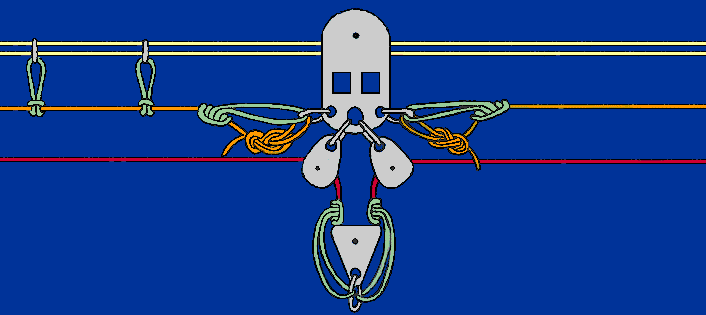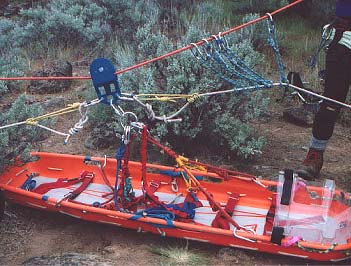RIGGING - ENGLISH REEVE
Rigging Home >> English ReeveCMRU uses the English reeve as an optional part of our highline system. It allows the litter to move both along the highline, whether horizontal or sloping, and also vertically. To move the litter along the highline, the reeve line is tied off and the litter movement is controlled by the tag lines. To move the litter vertically, the tag lines are tied off and reeve line is slackened or tensioned. Theoretically, it is possible to move in both dimensions simultaneously by carefully coordinating the control of both the reeve line and the tag lines together.
The English reeve is useful in several types of rescue situations, the most obvious of which is a boater stranded on a rock mid-river in a steep canyon. In this case, unless the subject is injured, a single appropriately equipped rescuer can be suspended where the litter is normally attached. It may also be appropriate to use an English reeve when it is necessary to remove someone from an unstable cliff face where it may be hazardous to the subject to approach from above and hazardous to the rescuers to approach from below. In this case we can use a highline with an English reeve to access the subject without touching the loose rock of the cliff.
Although useful, the English reeve on a highline has several drawbacks. We have found that it is rather time consuming to set up and requires a large, well coordinated team to run effectively. Also, although the weight of the load is principally borne by the track lines, the reeve line is a potentially dangerous weak link in the system. It is for this reason that a prusik is added on each side of the center pulley. If the reeve line fails, the prusik should set, thereby preventing the reeve line from slipping through the pulley. However, the addition of the prusiks adds a complication for the litter attendant who must now tend them whenever the reeve line is tensioned or slackened to prevent them from setting unnecessarily.

